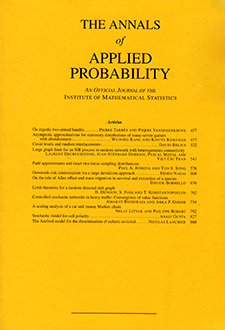Abstract
We consider the simple exclusion process with $k$ particles on a segment of length $N$ performing random walks with transition $p>1/2$ to the right and $q=1-p$ to the left. We focus on the case where the asymmetry in the jump rates $b=p-q>0$ vanishes in the limit when $N$ and $k$ tend to infinity, and obtain sharp asymptotics for the mixing times of this sequence of Markov chains in the two cases where the asymmetry is either much larger or much smaller than $(\log k)/N$. We show that in the former case ($b\gg (\log k)/N$), the mixing time corresponds to the time needed to reach macroscopic equilibrium, like for the strongly asymmetric (i.e., constant $b$) case studied in (Ann. Probab. 47 (2019) 1541–1586), while the latter case ($b\ll (\log k)/N$) macroscopic equilibrium is not sufficient for mixing and one must wait till local fluctuations equilibrate, similarly to what happens in the symmetric case worked out in (Ann. Probab. 44 (2016) 1426–1487). In both cases, convergence to equilibrium is abrupt: we have a cutoff phenomenon for the total-variation distance. We present a conjecture for the remaining regime when the asymmetry is of order $(\log k)/N$.
Citation
Cyril Labbé. Hubert Lacoin. "Mixing time and cutoff for the weakly asymmetric simple exclusion process." Ann. Appl. Probab. 30 (4) 1847 - 1883, August 2020. https://doi.org/10.1214/19-AAP1545
Information





